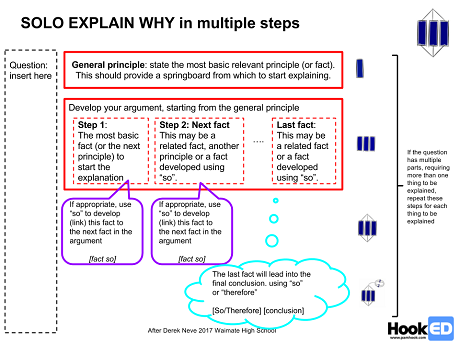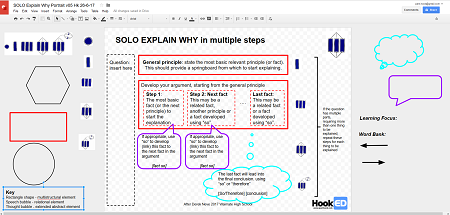I have recently enjoyed thinking with Derek Neve (Waimate High School) about the challenges in making “explanation” visible to senior secondary students (NCEA Levels 1 to 3).
When visiting Waimate High School this term Derek challenged me to develop a visual SOLO map and rubric to support a deeper factorial and sequential explanation process than that allowed in my existing SOLO Explain Causes Map and rubric. My simpler existing SOLO Explain Causes map allows students to draft their thinking for simple causal explanation – it uses connectives like “because’ and “so that” – allows multiple causes for an outcome. It fits with David Rose’s descriptors of factorial explanation types (see below). It works well to draft simple explanations BUT it does not support the deeper explanation patterns required in senior secondary school.
Explanations – how processes happen
Explanations imply sequences of causes and effects: process x occurs, so process y results, which in turns causes process z, and so on. This kind of logical pattern has been termed an implication sequence (Halliday & Martin 1993). The typical structure of explanations is to start by specifying the Phenomenon to be explained, followed by the implication sequence that explains it, i.e. the Explanation stage. Explanation genres are of four general types: a sequence of causes and effects (sequential), multiple causes for an outcome (factorial), multiple effects from an input (consequential), or multiple conditions and effects (conditional). David Rose The Routledge Handbook of Discourse Analysis. James Paul Gee and Mike Handford (eds) London: Routledge, 2010
Derek had already done a lot of thinking about this and had developed a process of steps to help his students explain in depth. Refer – Waimate HS Science Department Literacy Initiative (Writing Skills), 27 Jan 2017. His thinking is elegant. It involves a detailed 5 to 6 step process and you can learn more about by contacting Derek through the contact form on the website or by posting a comment on this post.
As Derek explains
“By Level 1 NCEA, there are usually a number of steps in the reasoning for most explanations.
A question asking the student to explain why methane has a very low boiling point is typical and illustrates the second point above:
- there is a general principle to be stated as the basis of the explanation (in this case: There are three types of intermolecular forces: hydrogen bonding, permanent dipole attractions and temporary dipole attractions);
- there is then some analysis to be done, in order to apply the general principle to the specific subject matter of the question (ie: Methane is non–polar so it does not have any permanent dipole forces of attraction; neither does it have hydrogen bonded to F, O or N, so it does not have any hydrogen bonding);
- there is a conclusion to be drawn from the analysis stage (ie: The only intermolecular forces between methane molecules are weak temporary dipole attractions, so the attractive forces between methane molecules are weak);
- then the bond strength needs to be related to the temperature and kinetic energy (ie: Relatively little heat is required for the methane molecules to gain sufficient kinetic energy to overcome the weak intermolecular forces present in the liquid state and become a gas.)
- then there is the final conclusion (ie: Therefore, methane has a very low boiling point.)
An explanation of this sort becomes extremely difficult (and dangerous) if starting with a sentence such as “Methane has a very low boiling point because there are only weak intermolecular forces between the molecules.” By trying to start with the conclusion, the student has started at the wrong end of the explanation. Because the student hasn’t yet worked through the explanation logically, to reach the conclusion, there’s a heightened risk that the “because” sentence won’t even be correct. But if it is correct, it’s pretty much a wasted sentence, because the student has to back up to explain why the molecule has weak intermolecular forces, what those forces are and what the significance of those forces is in terms of boiling point. In other words, after starting with a risky “because” statement, the student has to go back and work back through to the point they started at.”
We are still playing with the design BUT we are pretty chuffed with our attempts to make explanation visible in a senior science secondary context. Please ask if you would like a link to the Google Draw map and more detail around the process behind its construction







{ 4 comments… read them below or add one }
I’m supporting curriculum officers in Kiribati writing Teacher Guides. A step by step structure would be invaluable as they struggle themselves with clear explanations
I use SOLO in the lower school science department and this looks excellent for explaining to them as part of an introduction, how an argument/explanation is structured. Please could I have a link to the Google draw map? Thanks
I am wanting to use this for explaining different sections for the Homeostasis standard
Hi Hazel – I have sent you a link to the map – It is in the WHS Google Drive SOLO Resources – Science Folder. Make a copy for your own use. Regards Pam